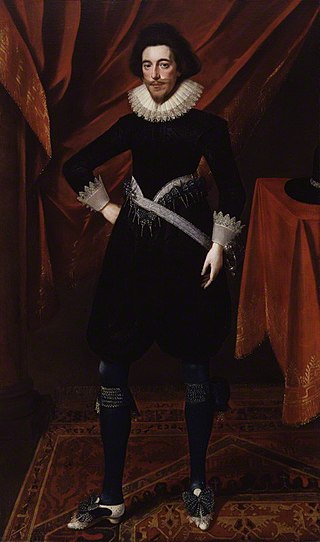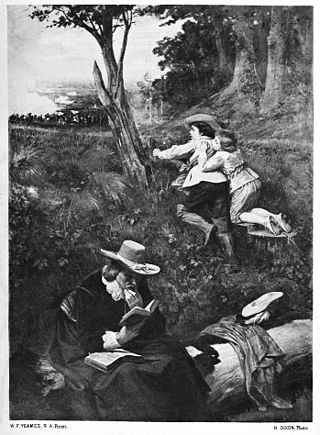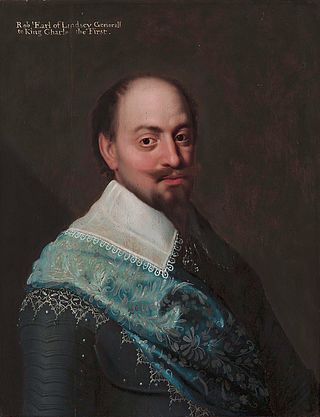The Battle of Lostwithiel took place over a 13-day period from 21 August to 2 September 1644, around the town of Lostwithiel and along the River Fowey valley in Cornwall during the First English Civil War. A Royalist army led by Charles I of England defeated a Parliamentarian force commanded by the Earl of Essex.

Robert Devereux, 3rd Earl of Essex, KB, PC was an English Parliamentarian and soldier during the first half of the 17th century. With the start of the Civil War in 1642, he became the first Captain-General and Chief Commander of the Parliamentarian army, also known as the Roundheads. However, he was unable and unwilling to score a decisive blow against the Royalist army of King Charles I. He was eventually overshadowed by the ascendancy of Oliver Cromwell and Thomas Fairfax, and resigned his commission in 1646.

The Battle of Edgehill was a pitched battle of the First English Civil War. It was fought near Edge Hill and Kineton in southern Warwickshire on Sunday, 23 October 1642.

The First Battle of Newbury was a battle of the First English Civil War that was fought on 20 September 1643 between a Royalist army, under the personal command of King Charles, and a Parliamentarian force led by the Earl of Essex. Following a year of Royalist battlefield successes, in which they took Banbury, Oxford and Reading without conflict before storming Bristol, the Parliamentarians were left without an effective army in the west of England. When Charles laid siege to Gloucester, Parliament was forced to muster a force under Essex with which to beat Charles' forces off. After a long march, Essex surprised the Royalists and forced them away from Gloucester before beginning a retreat to London. Charles rallied his forces and pursued Essex, overtaking the Parliamentarian army at Newbury and forcing them to march past the Royalist force to continue their retreat.
Francis Willoughby, 5th Baron Willoughby of Parham was an English peer of the House of Lords.

Robert Bertie, 1st Earl of Lindsey KG, previously 14th Baron Willoughby de Eresby was an English peer, soldier and courtier.

The Battle of Gainsborough took place during the First English Civil War on 28 July 1643. The strategically important town of Gainsborough, Lincolnshire, was a Royalist base used for harassing the Parliamentarians who were generally dominant in Lincolnshire, but was taken by Parliamentarians in July 1643. An attempt to recapture Gainsborough by Charles Cavendish and the Royalists was foiled in a battle in which Colonel Oliver Cromwell distinguished himself as a cavalry leader.
The Eastern Association of counties was an administrative organisation set up by Parliament in the early years of the First English Civil War. Its main function was to finance and support an army which became a mainstay of the Parliamentarian military effort until early 1645. In January 1644 committeemen of the Eastern Association gathered at the Bury Conference to discuss their concerns as regards the proposed New Model Army. However in the following months many of its units were incorporated into this new military formation.
The Battle of Brentford was a small pitched battle which took place on 12 November 1642 in Brentford, Middlesex, between a detachment of the Royalist army under the command of Prince Rupert, and two infantry regiments of Parliamentarians with some horse in support. The result was a victory for the Royalists.

Cornwall played a significant role in the English Civil War, being a Royalist enclave in the generally Parliamentarian south-west.
The Battle of Aldbourne Chase was a relatively small battle of the First English Civil War that occurred on 18 September 1643. In the skirmish the Royalist cavalry led by Prince Rupert attacked the extended columns of the Parliamentarian army of the Earl of Essex at Aldbourne Chase, Wiltshire, as he was attempting to get his army to London.
The First English Civil War started in 1642. By the end of the year neither side had succeeded in gaining an advantage, although the King's advance on London was the closest Royalist forces came to threatening the city.
1643 was the second year of the First English Civil War. Politically, the latter months of the year were the turning-point of the war. The King made a truce with the Irish rebels on 15 September which united against him nearly every class in Protestant England. Only ten days after the "Irish Cessation," Parliament at Westminster swore to the Solemn League and Covenant, and the die was cast.

Worcestershire was the county where the first battle and last battle of the English Civil War took place. The first battle, the Battle of Powick Bridge, fought on 23 September 1642, was a cavalry skirmish and a victory for the Royalists (Cavaliers). The final battle, the battle of Worcester, fought on 3 September 1651, was decisive and ended the war with a Parliamentary (Roundhead) victory and King Charles II a wanted fugitive.

The Battle of Camp Hill, also known as the Battle of Birmingham, took place on Easter Monday, 3 April 1643, in and around Camp Hill, Warwickshire, during the First English Civil War. In the skirmish, a company of Parliamentarians from the Lichfield garrison with the support of some of the local townsmen, approximately 300 men, attempted to stop a detachment of 1,400 Royalists under the command of Prince Rupert from passing through the unfortified parliamentary town of Birmingham.
Colonel John "Tinker" Fox (1610–1650), confused by some sources with the MP Thomas Fox, was a parliamentarian soldier during the English Civil War. Commanding a garrison at Edgbaston House in Warwickshire – a location that guarded the main roads from strongly parliamentarian Birmingham to royalist Worcestershire – Fox operated largely independently of the parliamentarian hierarchy, all factions of which tended to view him with suspicion. Though lauded by the parliamentarian press for his "continual motion and action", to royalist propagandists Fox became an icon of dangerous and uncontrolled subversiveness, being decried as a "low-born tinker" whose troops "rob and pillage very sufficiently". By 1649 Fox's notoriety was such that he was widely, though wrongly, rumoured to be one of the executioners of Charles I.
Sir William Godolphin was an English soldier and politician who sat in the House of Commons in 1640. He fought for the Royalist cause in the English Civil War.
Colonel Sir Gilbert Gerard was a Royalist officer during the English Civil War.
The Battle of Stourbridge Heath was a skirmish that took place during the First English Civil War, in which a Parliamentarian contingent under the command of Colonel "Tinker" Fox was defeated by a larger Royalist force under the command of Sir Gilbert Gerard, Governor of Worcester.

The siege of Lichfield occurred on 8–21 April 1643 during the First English Civil War. During the military action, the Royalists under the command of Prince Rupert successfully besieged the Parliamentary garrison of Lichfield in Staffordshire under the command of Colonel Russell.










